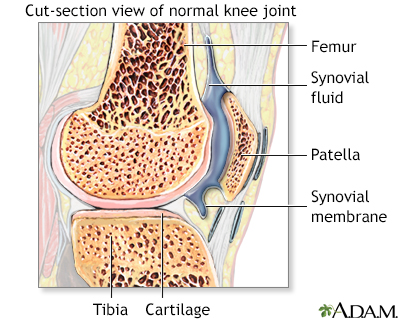Pregnancy SmartSiteTM
DefinitionAn autoimmune disorder occurs when the body's immune system attacks and destroys healthy body tissue by mistake. There are more than 80 autoimmune disorders. CausesThe blood cells in the body's immune system help protect against harmful substances. Examples include bacteria, viruses, toxins, cancer cells, and blood and tissue from outside the body. These substances contain antigens. The immune system produces antibodies against these antigens that enable it to destroy these harmful substances. When you have an autoimmune disorder, your immune system does not distinguish between healthy tissue and potentially harmful antigens. As a result, your body sets off a reaction that damages or destroys normal tissues. The exact cause of autoimmune disorders is unknown. One theory is that some microorganisms (such as bacteria or viruses) or medicines may trigger changes that confuse the immune system. This may happen more often in people who have genes that make them more prone to autoimmune disorders. An autoimmune disorder may result in:
An autoimmune disorder may affect one or more organ or tissue types. Areas often affected by autoimmune disorders include:
A person may have more than one autoimmune disorder at the same time. Common autoimmune disorders include:
SymptomsSymptoms will vary, based on the type and location of the faulty immune response. Common symptoms include:
Exams and TestsYour health care provider will do a physical exam. Signs on an exam depend on the type of disease. Tests that may be done to diagnose an autoimmune disorder include:
TreatmentThe goals of treatment are to:
Treatments will depend on your disease and symptoms. Types of treatments include:
Many people take medicines to reduce the immune system's abnormal response. These are called immunosuppressive medicines. Examples include corticosteroids (such as prednisone) and nonsteroid medicines such as azathioprine, cyclophosphamide, mycophenolate, sirolimus, or tacrolimus. Targeted medicines such as tumor necrosis factor (TNF) blockers and Interleukin inhibitors can be used for some diseases. Outlook (Prognosis)The outcome depends on the disease. Most autoimmune diseases are chronic, but many can be controlled with treatment. Symptoms of autoimmune disorders can come and go. When symptoms get worse, it is called a flare-up. Possible ComplicationsComplications depend on the disease. Medicines used to suppress the immune system can cause severe side effects, such as higher risk for infections. When to Contact a Medical ProfessionalContact your provider if you develop symptoms of an autoimmune disorder. PreventionThere is no known prevention for most autoimmune disorders. ReferencesKono DH, Peterson EJ, Theofilopoulos AN. Immune tolerance and autoimmunity. In: Firestein GS, McInnes IB, Koretzky GA, Mikuls TR, Neogi T, O'Dell JR, eds. Firestein & Kelley's Textbook of Rheumatology. 12th ed. Philadelphia, PA: Elsevier; 2025:chap 21. Kumar V, Abbas AK, Aster JC. Diseases of the immune system. In: Kumar V, Abbas AK, Aster JC, eds. Robbins and Cotran Pathologic Basis of Disease. 10th ed. Philadelphia, PA: Elsevier; 2021:chap 6. Peakman M, Buckland MS. The immunity. In: Feather A, Randall D, Waterhouse M, eds. Kumar and Clarke's Clinical Medicine. 10th ed. Philadelphia, PA: Elsevier Limited; 2021:chap 3. | ||
| ||
Review Date: 5/19/2025 Reviewed By: Jacob Berman, MD, MPH, Clinical Assistant Professor of Medicine, Division of General Internal Medicine, University of Washington School of Medicine, Seattle, WA. Also reviewed by David C. Dugdale, MD, Medical Director, Brenda Conaway, Editorial Director, and the A.D.A.M. Editorial team. View References The information provided herein should not be used during any medical emergency or for the diagnosis or treatment of any medical condition. A licensed medical professional should be consulted for diagnosis and treatment of any and all medical conditions. Links to other sites are provided for information only -- they do not constitute endorsements of those other sites. No warranty of any kind, either expressed or implied, is made as to the accuracy, reliability, timeliness, or correctness of any translations made by a third-party service of the information provided herein into any other language. © 1997- A.D.A.M., a business unit of Ebix, Inc. Any duplication or distribution of the information contained herein is strictly prohibited. | ||


 Graves disease
Graves disease Hashimoto's diseas...
Hashimoto's diseas... Multiple sclerosis
Multiple sclerosis Rheumatoid arthrit...
Rheumatoid arthrit... Rheumatoid arthrit...
Rheumatoid arthrit... Systemic lupus ery...
Systemic lupus ery... Synovial fluid
Synovial fluid Rheumatoid arthrit...
Rheumatoid arthrit... Antibodies
Antibodies
